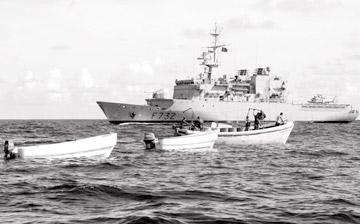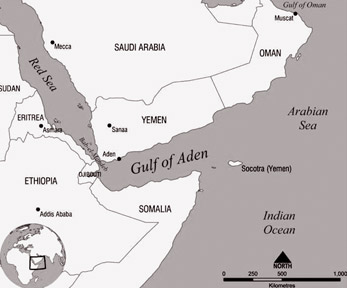Nip infiltration of Somali pirates in the bud
By Manjula FERNANDO
|

Captain Sarath Weerawansa
|
Captain Sarath Weerawansa, a seasoned seafarer has worked on
international merchant ships for over 30 years. A retired Air Force
officer, he has braved many rough seas and storms and survived a most
terrifying near death experience during his life at sea.
A duty conscious sailor, he had manned cargo vessels to destinations
where seafarers dreaded to even think of. He has been to lawless Somalia
twice and became a hostage of Somali authorities who he says are no
different than ruthless pirates, for seven months. While there with his
crew, he almost died of starvation and disease. His outspokenness too
almost cost him his life. The Sunday Observer wrote of his terrifying
experiences at the hands of Somali war lords last year. Captain
Weerawansa spoke on the threat that lurks out there close to Sri Lankan
territorial waters - of the infiltration of Somali pirates into South
Asia.
“I hope the Navy will exert pressure on the Somali pirates and drive
them off. They have come so close to Sri Lankan territorial waters. I
think it is best if they combat these ruthless killers before the issue
becomes fully blown and disastrous.
The Sri Lankan Navy at one time braved international waters and
destroyed LTTE re-supply vessels. Why can’t they do the same with these
pirates? It seems like the Navy is facilitating them. The Somali pirates
cannot be trusted or controlled by anyone.
The latest trick of the pirates is that they use fishing vessels as
bait. They capture fishing vessels first and send out distress calls.
The merchant ships reaching out to rescue these vessels are then
ambushed by the Somalis.
This has happened close to Indian and Lankan waters in recent times.
The pirates are venturing out deep down into the Indian Ocean,
towards India, Sri Lanka and Maldives.
This could well be the reason why they killed two Lankan fishermen
recently. “If you don’t budge or bow down to their orders, you will be
good as dead meat.” Capt Weerawansa said through experience.
“These fishermen would not have wanted to let go of their trawler.

Three pirate boats captured by a French naval craft |

Pirate territory |
Ultimately the price was two lives.”
Our ships go way beyond our territory. They go as far as Madagascar
and Somalia. One reason why the Somalis took to the trade of piracy is
because foreigners began exploiting their traditional fishing grounds.
When they lost their fishing harvest to outsiders they took up to the
more lucrative piracing. This is one story we seafarers have heard from
other seafarers and our predecessors.
When I was held by the Somali port authorities at the Berbera Port, I
saw foreign fishermen being hurled in and imprisoned for breaching their
territorial fishing grounds.
Our fishermen although equipped with GPS and VHS technology, are
barely conversant with the technical know how to put the equipment to
good use. They struggle with maps. This is one reason why they drift off
towards Maldives, Seychelles and Madagascar waters and become prisoners
in foreign lands. There is no point in giving them the latest technology
without the competency to handle it.
It is indeed disturbing that the Somalis have arrived into South
Asian waters. Especially in the light that Sri Lanka is aspiring to
become South Asia’s maritime hub.
Weerawansa says the Somali wives are hard workers but the men are too
lazy to make a proper living. They go for easy money. Piracy for them
means easy money. This is the way to live a sultan’s life, own the
latest model of an expensive car and a new and pretty wife.
Young Somalians are highly impressed by this easy money spinning
occupation.
Among the 28 sea pirates apprehended by the Indian navy after the
aborted attack on the Korean vessel heading towards Sri Lanka recently,
there had been six to seven underage pirates. The police believe they
are below 18 years of age.
“This is the new trend in Somalia. Unless the super powers intervene,
the situation is only going to get worse. Countries like Sri Lanka which
are very much in the hope of expanding maritime operations will have a
tough time in the future. Over 5000 ships call over at Colombo Port
every year.
Somali pirates are ruthless killers and they operate in groups. Those
who capture the ships are trained to do only that. Their mission will be
over as soon as they overpower the crew and capture the vessel.
Then the Somalis force the captain to send out a message to the
owners that the ship is captured and a ransom is sought. The second
batch of pirates sail in. Their mission will be to sail the ship safely
(with the help of the hostages) to some secret location along the Somali
coast, to be hidden until the ransom is collected.
Once the delivery is accomplished, a different band of pirates take
over. They will feed the hostages and make sure the ship is in order to
be released back to its owners once their demands are met.
These pirates are rather ruthless. They kill their hostages
mercilessly if their orders are defied.
Capt. Weerawansa once witnessed such a horrific drama. When he was
under the arrest of the Somali landlords, a ship which was taken hostage
was moored in. The Captain of the ship was called on to the bridge. The
man was killed unceremoniously by slashing his throat with a sharp
blade.
Capt. Weerawansa says the pirates have counterparts based in other
countries where maritime operations via the infested route are
coordinated. They tip off the pirates on potential targets as early as
before the ships barely leave port. These third parties actively take
part in ransom negotiations as well.
They don’t have to linger for long in the sea. The maximum waiting
time is one week.
They get information from agents in Dubai or from the Gulf. On the
other side when ships enter Suez Canal towards red sea, the pirates are
tipped off by their agents.
They come in big wooden ‘dove’ boats. These can accommodate a lot of
goods in their special cargo holes such as fast dinghy boats, weapons,
food and water for even two months and stock pile fuel for a long stay
at sea.
They maintain close contacts with Muslim extremists and terrorists
from Yemen and others places like Al Qaeda.
Most captains are terrified of these terrorists because they carry
powerful AK-47s and RPGs. If we don’t surrender, they can attack the
bridge or the engine room and even sink the vessel.
The ships are allowed to carry a few weapons but we cannot match
their fire power. Even the fast crafts/dinghy boats in which they swoop
in are much faster than our vessels. They are powered by 250 hp out
board motors. We try to alter our course and shake them off but we fail
in most instances.
Their much faster crafts can catch up with us in about 30 minutes
time.
The pirates most commonly pose as fishermen. As soon as they smell
the prey they put out their dinghy boats from the mothership and start
the chase.
Our radars cannot detect the threat until we come significantly
closer to the pirates. When we feel the boats are heading directly
towards us at a high speed we begin to suspect them’. There is no other
way. The pirate craft about 30 - 40 miles away is just another dot on
the radar.
They then surround the ship in dingy boats and shoot into the air
hailing the vessel or the ship to stop.
Then they board the ship and summon the entire crew to the mess,
demand the engineer to take the vessel to a given position (hide out
position) and drop anchor.
Subsequently at gun point the crew is hurled into a saloon with their
personal belongings are looted. Then, cellular phones are collected and
all expensive belongings are looted. Then through the satellite phone
they initiate contact with the ship’s owner and inform how much of
ransom is money needed to release the crew and the ship.
There are naval war ships of NATO, US, European Union etc, operating
in this pirate infested region. (A total of 28 nations jointly comb the
Gulf of Aden where these pirates operate but the joint forces have not
been able to eliminate their operations so far) If they are really
serious about it, it would take only a few days for these super powers
to eliminate Somali sea warlords. My personal opinion is that they do
not want to. If not how can they station their war ships in the back
yards of their rivals?
The joint patrols by Southeast Asian nations combatted and eliminated
pirates that once plagued straight off Malacca, a vital route for oil
tankers. So this is no mission impossible.
Our Forces eliminated the LTTE when everyone else thought it was
impossible. The Somali pirates should be dealt with in the same way.You
must fight fire with fire.
Capt. Weerawansa, now 64 years old is still an active seafarer. He
returned to the country recently after a three month voyage as the
skipper of a Dubai based cargo vessel.
|

